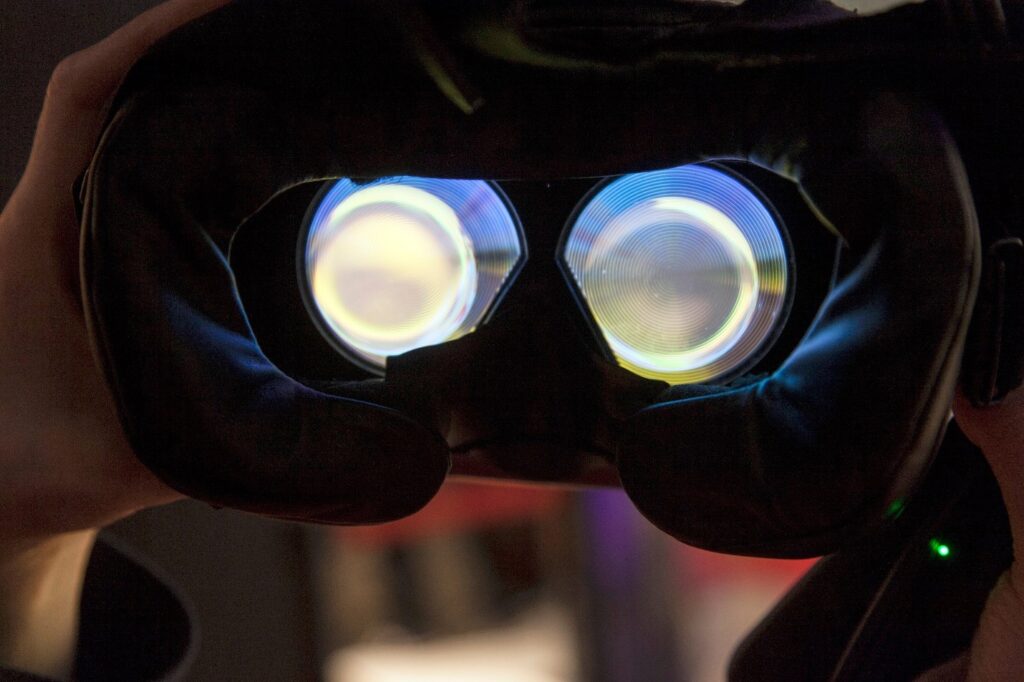Does Apple hold the key to meeting your future self in VR?
I know, I know, another article about Apple. But Apple launched the much-anticipated Vision Pro headset this week at its 2023 Developer Event and I feel like it’s worth discussing.

What all VR headsets have failed to do so far is come up with a killer application
It is an interesting move, as the VR/AR headsets market and the “metaverse” more generally seem to be firmly in the trough of disillusionment.
The new Apple headset packs a punch, including a 4K screen per eye, meaning you can look at photos or watch films.
But will it be enough? Poor sales of headsets generally (according to IDC, only 8.5 million were sold last year, and global shipments of AR/VR headsets have declined 54.4% year over year in Q1 2023), including Meta’s Oculus, which starts at a much lower price-point than the $3,500 that Apple’s new headset costs, imply that headsets have failed to cut through. And usage has been even worse.
Ever since I first tried Google Glass, I have puzzled over headsets and whether they have a place beyond operating theatres and heavy industry. Google Glass was magical and yet frustrating. After using it, my conclusion was that the most exciting thing about it was voice control – something that is now so commonplace. Otherwise, I scratched my head and failed to come up with a use case for it.
I then bought the Microsoft AR headset, Hololens, and even persuaded a client to invest in a concept (thank you, HSBC), which was a work of art. What was the most fascinating thing about Hololens? It was the consumer testing we did in Hong Kong, where the ladies we were testing with (rightly) refused to put it on because they were worried about their hair.
I have bought my sons Oculus 1, 2 and 3. And each time, the same pattern. They use it for a week, then that’s it.
It is not just my sons. People are buying headsets, giving them a go, and leaving them on the shelf to gather dust.
So why does Apple think it has a device that will succeed where others have failed? According to the Financial Times, the headset is a hedge against the future. Apple is worried about disruption in its core market of phones and sees the headset as a horse in the emergent metaverse. If the metaverse is currently in the trough of disillusionment, then the only way is up. Apple has form. I remember going to CES in Las Vegas in 1999. It was the year of the MP3 player. Apple waited another two years before launching the iPod in October 2001.
I keep going back to the ladies in my testing in HK. The fact is that people do not want to don heavy headsets. Post-Covid, people are even more acutely aware of passing infections, and sharing headsets is an anathema.
Obviously, I will have to buy an Apple headset, just to be sure. But until headsets are small and light enough, like a pair of spectacles, I believe Apple will fail, just like the others.
What all of these devices have failed to do is come up with a killer application. In fact, this is the problem for the metaverse. What are the use cases?
I am pleased to say that I have unearthed one. Last year, I worked with one of the UK’s biggest insurance companies on a project on wealth management and pensions.
I undertook some research which showed that people are generally brilliant at managing money in the here and now, but ask them to think about the future, and it all falls apart. However, we tend to listen and trust those around us – our family and friends. This project coincided with some other work I was doing on the metaverse. I hypothesised that if we listen to people we trust, we might also listen to ourselves, and proposed a metaverse solution in which we use VR to meet our future self and also talk to our younger selves. It could look fantastic using digital twinning, ageing filters and childhood photos mixed with a dash of generative AI. The tumbleweed response I got suggested I was slightly ahead of the curve.
But I have discovered that a behavioural economist, Hal Hershfield, at the University of California, Los Angeles, has had similar thoughts. He created an experiment where participants could meet either their current or future selves in VR by looking into a virtual mirror. They used a filter to age participants, giving them grey hair and wrinkles. Just looking at their future selves changed people. When asked what they would do with $1,000, those who had seen their future selves were likelier to say they would save the money.
Access to virtual reality gear isn’t necessary for fostering a connection with your future self. You can achieve the same effect using ageing features on applications like FaceApp or Snapchat filters. Another study conducted by Hershfield and his colleagues provides insight into this. They asked a group of employed individuals about their hypothetical preferences for retirement savings. During this process, some participants were shown images of their future selves, while others were shown their present selves derived from uploaded photographs. Those presented with their current images were willing to invest about 2% of their income, while those confronted with their future selves were more inclined to set aside 6% of their earnings, according to a recent article by Miriam Frankel in New Scientist.
These results show that the propensity to save is impacted by simply showing us images of our future selves. Imagine how powerful it could be to take that next step and, through virtual reality, actually meet, converse and interact with your future self.
If Hershfield’s findings are correct, the economics for developing such a solution stack up. A potentially remarkable use case which could make a difference!
About the author
 Dave Wallace is a user experience and marketing professional who has spent the last 25 years helping financial services companies design, launch and evolve digital customer experiences.
Dave Wallace is a user experience and marketing professional who has spent the last 25 years helping financial services companies design, launch and evolve digital customer experiences.
He is a passionate customer advocate and champion and a successful entrepreneur.
Follow him on Twitter at @davejvwallace and connect with him on LinkedIn.









































